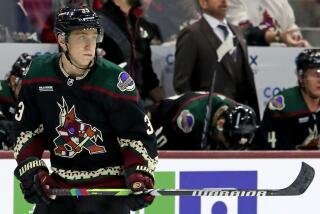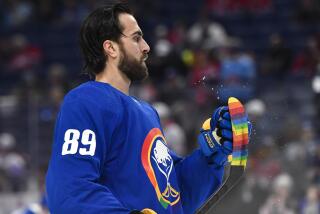NHL players going from ice time to Face(book) time
- Share via
Hockey fans will remember this summer for llya Kovalchuk’s endless free-agent odyssey and the NHL’s attempt to rewrite the collective bargaining agreement in midstream, but it will also be remembered as the summer NHL players plunged into using social media sites such as Facebook and Twitter and stepped into uncharted waters.
Including Kings captain Dustin Brown, who began tweeting in August, and Ducks winger Bobby Ryan, who hit the Twitterverse in July, more than 40 players are Twitter users. That estimate came from Michael DiLorenzo, the NHL’s director of social media marketing and strategy. He added that fewer than 40 players also use Facebook or have fan pages on Facebook.
Most players’ Twitter messages are funny: Ryan gets impatient in California traffic and Brown, watching Saturday morning TV with his kids, wondered what happened to all the good cartoons. Both needle teammates and talk about workouts and dinner plans, not revelations but information that gives them distinct personalities and builds rapport with fans.
Along with trivial uses come some noble uses. Brown’s tweets about building a playground in Carson triggered offers of help from fans. Player agent Allan Walsh, a pioneer in getting players involved with Twitter and Facebook, spread word that former Canadiens goaltender Jaroslav Halak would sign autographs for charity at a Montreal shopping center this weekend. Brown’s agent, Scott Norton, started a program in which his clients will perform a good deed every Monday and tweet about it in hopes of inspiring similar acts. That can’t be bad.
But what happens when a player takes to social media to complain about a referee’s call or about being benched?
DiLorenzo said the league will treat a derogatory tweet or post the same way it would treat a derogatory comment made on TV, in a newspaper or through another medium. But a lot of gray areas remain and the NHL is examining how to balance the potential for invaluable promotion against the potential for harm.
“We have not had a policy governing the use of social networks by players but are in the process of developing one,” DiLorenzo said via e-mail. “We have, at times, provided counsel to clubs and even individual players on some basic guidelines for sensible usage.”
The NHL and “sensible” don’t often go together. But teams will have to devise guidelines, if not firm rules.
A Ducks spokesman said the team plans to address the issue during training camp. Mike Altieri, the Kings’ vice president for communications, said the team encourages players to use social media platforms “with the understanding that they are representatives of our organization and they should do so by following organizational guidelines … with anything new there are always potential unforeseen pitfalls. We don’t feel that anything that could occur outweighs the benefits of participating in this area.”
Walsh, based in Los Angeles, said he urges his clients to use common sense on Twitter and Facebook. “There are certain areas players should not go into. One problem with Twitter is the boundaries have yet to be defined,” he said.
But the benefits can be substantial, chiefly gaining recognition for players in a league that promotes a select few superstars and ignores most of the rest. Through engaging and insightful tweets David Perron of St. Louis, a 20-goal scorer last season and a client of Walsh’s, has built a following of more than 15,000. He promised to make a donation to charity when he hits 20,000.
“It’s about interacting with fans and what amazing personalities these players have,” Walsh said. “For so many years this league prevented players from appearing as individuals and tried to market teams as logos and cities and arenas as opposed to putting these remarkable personalities out there.”
Norton said he knew little about social media six months ago. Now he has nearly a dozen clients on Twitter and used it to clarify why client Bill Sweatt signed with Vancouver instead of Toronto.
“I think the sport is the best and hockey players are the best people to deal with,” said Norton, who is moving his offices from Chicago to Southern California. “The people in the NHL have been trying to market by the names on the front of the jersey not the back. They’re trying to sell the team over the players. But there has to be some understanding of who these players are.”
And an understanding of how to use these new platforms to their best advantage. Norton suggested rules governing players’ social media usage might have to be determined in the next collective bargaining agreement — another item for the NHL and the players’ association to fight over and one that will take more than 140 characters to spell out.
helene.elliott@latimes.com
twitter.com/helenenothelen
More to Read
Go beyond the scoreboard
Get the latest on L.A.'s teams in the daily Sports Report newsletter.
You may occasionally receive promotional content from the Los Angeles Times.







